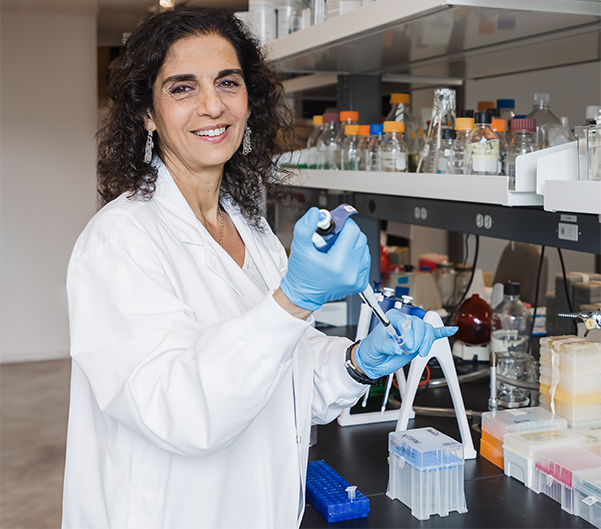Peter Pan and pediatric cancer: Dr. Nada Jabado’s search for transforming therapies

In 2012, Dr. Nada Jabado made a discovery that transformed the understanding and treatment of pediatric brain cancer. In recognition of her groundbreaking research, Dr. Jabado was appointed to the Order of Canada, honoured by UNESCO and the Canadian Cancer Society and made a Fellow of the Royal Society of Canada. The World Health Organization (WHO) updated its classifications of central nervous system tumours twice in response to Dr. Jabado’s discoveries. Her work not only reshaped how pediatric brain cancers are classified and treated but continues to inspire new research into targeted therapies for these devastating diseases.
Originally an immunologist, Dr. Jabado transitioned into hemato-oncology after moving from France to Canada in 2003. Upon joining the Montreal Children’s Hospital, she was struck by the lack of research on pediatric brain cancer, despite it being the leading cause of non-accidental death in children in Canada. “It was a desert,” she recalls. “Nothing was known about tumours in children, and treatments were copied and pasted from adult treatment plans. Not surprisingly, the results were dismal.” Determined to find better treatments for her young patients, Dr. Jabado decided to research when these tumours form and how they develop.
Dr. Jabado and her research team discovered that brain tumours in children differ from those in adults, even when they look similar under a microscope. They also found that nearly half of pediatric glioblastomas, an aggressive type of brain tumour, are caused by genetic mutations in a protein called histone 3, which helps control how DNA is organized and read inside cells. These mutations not only cause the tumour to grow but are also linked to the tumour’s location in the brain, the age at which it appears, and its clinical behaviour. “It’s like Peter Pan,” she says, “because these mutations make cells grow without maturing or differentiating into normal brain cells.”
Because of her research, doctors now conduct genetic testing to detect specific histone mutations in pediatric brain tumours, instead of relying solely on how tumours appear under a microscope or where they occur in the child’s brain. This molecular profiling enables more accurate diagnoses and prognoses, and it changes the “one size fits all” treatment approach to more personalized therapies.
Dr. Jabado’s lab, which is partially funded by CIHR, is actively researching new targeted therapies for pediatric brain cancer. “We now rarely use radiation therapy for a subset of brain tumors that can benefit from targeted therapies,” she says. “Chemotherapy is still an option, but instead of having IV therapies every three weeks, we are exploring oral drugs. The challenge is that while these oral medications seem to shrink the tumour, there is a risk it will return once the medication is stopped.”
More research is needed to understand the mechanisms behind tumour regrowth and to develop strategies to prevent relapses. “Research is not a luxury — it’s a necessity,” says Dr. Jabado. “Without it, we won’t improve outcomes. Research is the foundation for safer and improved therapies — not only for cancer, but across all of medicine.”
At a glance
Issue
Brain tumours are the leading cause of cancer-related deaths in children under the age of 20 in Canada. More research is needed to develop targeted therapies that are less toxic and more effective.
Research
Dr. Jabado and her team discovered that pediatric brain tumours are genetically and molecularly distinct from those found in adults. This finding has changed the way childhood brain cancers are studied and treated, helping pediatric oncologists tailor treatments specifically for children, minimizing side effects and improving long-term outcomes. Dr. Jabado’s research on histone mutations in pediatric brain cancer was recognized by Nature as one of its “Milestones in Cancer.”
- Date modified: